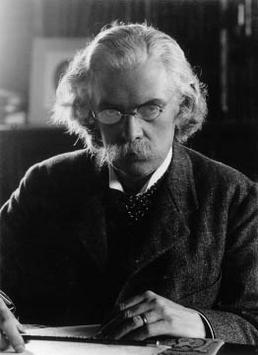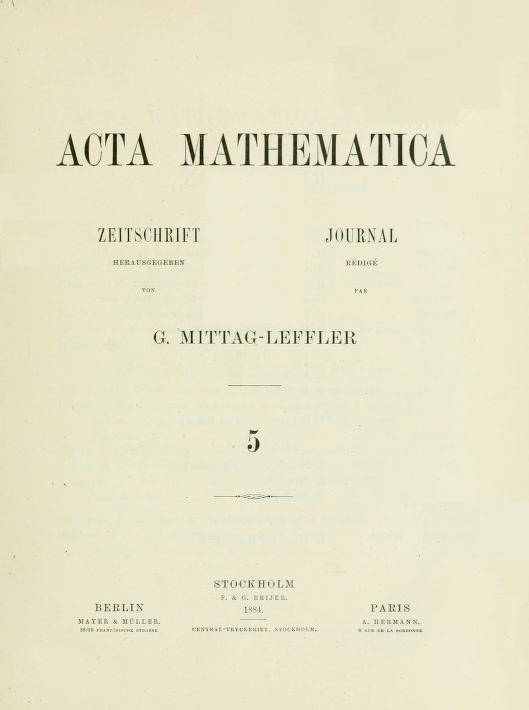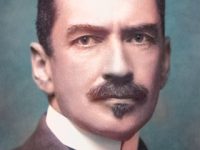
Magnus Gösta Mittag-Leffler (1846-1927)
On March 16, 1846, Swedish mathematician Gösta Mittag-Leffler was born. Mittag-Leffler‘s contributions are connected chiefly with the theory of functions. His mathematical research helped advance the Scandinavian school of mathematics. He is probably best known for founding the international mathematical journal Acta Mathematica.
“The mathematician’s best work is art, a high perfect art, as daring as the most secret dreams of imagination, clear and limpid. Mathematical genius and artistic genius touch one another. “
– Gösta Mittag-Löffler, quoted in [13]
Youth and Education
Mittag-Leffler was born in Stockholm, as the eldest of four siblings to the school principal John Olof Leffler and Gustava Wilhelmina Mittag. He later added his mother’s maiden name to his paternal surname. Both sides of the family were of German origin but had lived for several generations in Sweden. Gösta also showed his many talents as he progressed through school, and his teachers in elementary school and later those at the Gymnasium in Stockholm realised that he had an outstanding ability for mathematics.[1] He matriculated at Uppsala University in 1865. During his studies he supported himself by taking private pupils. He completed his Ph.D. in 1872 with a thesis on applications of the argument principle and became docent at the university the same year.
Hermite and Weierstrass
Perhaps the event which would have the greatest lasting effect on his life was being awarded a salary which came through an endowment with a condition attached which said that the holder had to spend three years abroad. In 1873 Mittag-Leffler set off for Paris, where he attended Charles Hermite‘s lectures on elliptic functions.[12] From there, he continued to Göttingen and Berlin, where he studied under Weierstrass, which proved to be extremely influential in setting the direction of Mittag-Leffler’s subsequent mathematical work.[11]
Academic Career and the Theory of Functions
He then took up a position as professor of mathematics at the University of Helsinki from 1877 to 1881 and then as the first professor of mathematics at the University College of Stockholm (the later Stockholm University). He was president of the college from 1891 to 1892 and retired from his chair in 1911. Mittag-Leffler made numerous contributions to mathematical analysis particularly in areas concerned with limits and including calculus, analytic geometry and probability theory. He worked on the general theory of functions, studying relationships between independent and dependent variables. His best known work concerned the analytic representation of a one-valued function, this work culminated in the Mittag-Leffler theorem. This study began as an attempt to generalise results in Weierstrass’s lectures where he had described his theorem on the existence of an entire function with prescribed zeros each with a specified multiplicity. Mittag-Leffler tried to generalise this result to meromorphic function while he was studying in Berlin.[1]

Acta Mathematica, 1884 Title Page
Acta Mathematica
In 1882, Mittag-Leffler founded the mathematical journal Acta Mathematica, with the help of King Oscar’s sponsorship, and partly paid for with the fortune of his wife Signe Lindfors, who came from a very wealthy Finnish family. He also served as chief editor of the journal for 45 years. Ever since the start it has been one of the most prestigious mathematics journals in the world. The original idea for such a journal came from Sophus Lie in 1881, but it was Mittag-Leffler’s understanding of the European mathematical scene, together with his political skills, which ensured its success.[8] He attracted substantial contributions from the French mathematician Henri Poincaré,[9] and in the early volumes he demonstrated his support for Georg Cantor’s work in set theory by publishing French translations of Cantor’s papers.[3]
The Case of Henry Poincaré
The journal’s “most famous episode” concerns Henri Poincaré, who won a prize offered in 1887 by Oscar II of Sweden for the best mathematical work concerning the stability of the Solar System by purporting to prove the stability of a special case of the three-body problem. The prize paper was to be published in Acta Mathematica, but after the issue containing the paper was printed, Poincaré found an error that invalidated his proof. He paid more than the prize money to destroy the print run and reprint the issue without his paper, and instead published a corrected paper a year later in the same journal that demonstrated that the system could be unstable. This paper later became one of the foundational works of chaos theory.
Businessman and Incubator
Mittag-Leffler went into business and became a successful businessman in his own right, but an economic collapse in Europe wiped out his fortune in 1922. He was a member of the Royal Swedish Academy of Sciences (1883), the Finnish Society of Sciences and Letters (1878, later honorary member), the Royal Swedish Society of Sciences in Uppsala, the Royal Physiographic Society in Lund (1906) and about 30 foreign learned societies, including the Royal Society of London (1896) and Académie des sciences in Paris. In 1883 Mittag-Leffler secured a position at the University of Stockholm for the Russian mathematician Sofya Kovalevskaya, the first woman to achieve such a post in modern Europe.[10] As a member of the Nobel Prize Committee in 1903, it was because of his intervention that the committee relented and awarded the prize for Physics to Marie Curie as well as her husband Pierre.
Why there is no Nobel Prize for Mathematics
Gösta Mittag Leffler died in 1927, at age 81. He left a large estate of about 20,000 letters with 3000 correspondents (Mittag-Leffler also kept copies of sent letters), most of which is in the Royal Library in Stockholm. In the past it was occasionally claimed that Alfred Nobel did not endow a Nobel Prize in mathematics because he feared out of personal animosity that Mittag-Leffler would then be forced to receive a prize as a leading Swedish mathematician.
The Poincaré Conjecture (special lecture) John W. Morgan [ICM 2006], [14]
References and Further Reading:
- [1] O’Connor, John J.; Robertson, Edmund F., “Gösta Mittag-Leffler“, MacTutor History of Mathematics archive, University of St Andrews.
- [2] Acta Informatica, original website
- [3] Magnus Gösta Mittag-Leffler, Swedish Mathematician, at Britannica Online
- [4] Henri Poincaré – the Last Universalist of Mathematics, SciHi Blog, April 29, 2014
- [5] Gösta Mittag-Leffler at zbMATH
- [6] Gösta Magnus Mittag-Leffler at Mathematics Genealogy Project
- [7] Gösta Mittag-Leffler at Wikidata
- [8] Sophus Lie and the Lie Theory, SciHi Blog, December 17, 2017.
- [9] Henri Poincaré – the Last Universalist of Mathematics, SciHi Blog, April 29, 2014.
- [10] Sofia Kovaleveskaya – Mathematician and Writer, SciHi Blog, January 15, 2016.
- [11] Karl Weierstrass – the Father of Modern Analysis, SciHi Blog
- [12] Charles Hermite’s admiration for simple beauty in Mathematics, SciHi Blog
- [13] N. Rose, Mathematical Maxims and Minims (Raleigh N C 1988).
- [14] The Poincaré Conjecture (special lecture) John W. Morgan [ICM 2006], @ Graduate Mathematics @ youtube
- [15] Gilman, D. C.; Peck, H. T.; Colby, F. M., eds. (1905). . New International Encyclopedia (1st ed.). New York: Dodd, Mead.
- [16] Timeline of Swedish mathematicians, via DBpedia and Wikidata





